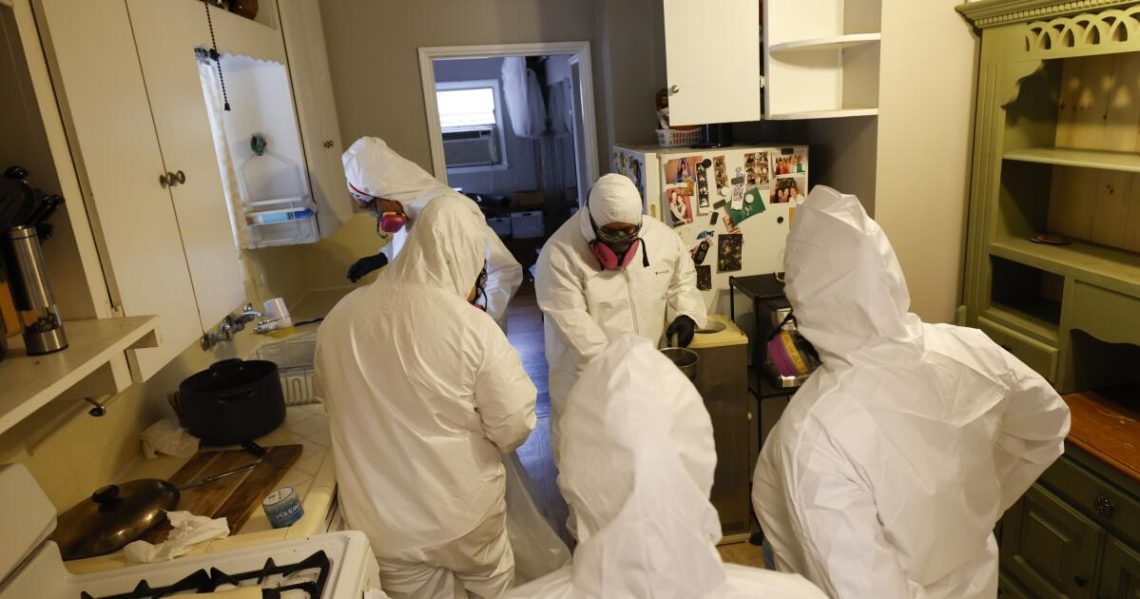More than half of still-standing homes within the area the Eaton fire’s ash settled had significant lead contamination even after extensive indoor remediation efforts, according to new findings announced Thursday from the grassroots advocacy group Eaton Fire Residents United. Additionally, a third of remediated homes tested positive for asbestos.
The results from 50 homes within and downwind of the Eaton burn area provide the first widespread evidence that the remediation techniques pushed by insurance companies and public health officials have not sufficiently removed contaminants deposited by the fire.
Long-term exposure to asbestos increases the risk of developing mesothelioma and other cancers, and long-term exposure to lead can cause permanent brain damage, especially in children, that leads to developmental delays and behavioral problems. No level of exposure to lead and asbestos comes without risks of adverse health effects.
“This is a community-wide problem,” said Nicole Maccalla, who leads EFRU’s data science. “It doesn’t matter what remediation you’re using, one pass is not establishing clearance based on the data that we have, which means that it is not yet safe to return to your home.”
That’s an issue given that many residents who have been staying elsewhere are returning home — especially those whose insurance money for temporary housing is running dry. EFRU leaders are encouraging residents to test their homes after remediation work, and, if the results show contamination, to keep remediating and testing until the lab results come back clean.
EFRU — born in January out of a frustration that no level of government was adequately addressing Altadena residents’ environmental health concerns — started by asking owners of standing homes to share the results of testing they had commissioned from professional labs both before and after remediation.
In March, EFRU was the first to publish comprehensive results from inside homes that had not yet been remediated: Out of the 53 professional testing reports homeowners shared with the organization, every household that tested for lead had found it.
A similar process was employed for this latest, post-remediation report. Homeowners hired testing professionals to come collect samples and run tests at certified labs, then they shared those results with EFRU. The organization then collated them in a database to give a wider-scope view of contamination in standing homes than any one single test could show.
Of the 50 total homes included in EFRU’s report, 45 were tested for lead, and 43 of those had at least some level of lead contamination.
Out of the 18 homes where professionals tested for lead on windowsills specifically, nine exceeded the corresponding level at which the Environmental Protection Agency typically requires further remediation. And out of the 24 homes tested for lead on floors specifically, 15 exceeded the EPA’s remediation level.
There are no official EPA remediation levels for asbestos dust on surfaces. However, asbestos dust was found in nine of the 25 homes that were tested for it in the EFRU report. The average concentration within those homes was significantly above the ad-hoc remediation level the EPA used in New York after 9/11.
“The number of houses tested is still very low, but considering that most of the homes have been remediated by professional companies, we would expect that all the homes should go below the EPA level,” said François Tissot, a Caltech geochemistry professor who began testing standing homes after the Eaton fire damaged his own. “That’s the promise of professional remediation.”
Now, EFRU is calling on the California Department of Insurance to implore insurers to cover testing and, if needed, multiple rounds of remediation. The group is also asking Gov. Gavin Newsom to declare an “ash zone,” which would formally recognize the impact of the fire’s smoke and ash beyond the immediate burn zone.
An ash zone, EFRU says, would raise public awareness around health concerns and take some of the burden off individual residents to prove to insurance companies that their home was affected.
The Department of Insurance did not immediately respond to a request for comment.
Tissot, who is not involved with EFRU but has been in communication with the group, previously found that wiped-down surfaces had about 90% less lead than those left untouched since the fire. It made EFRU’s findings particularly surprising.
“To see that we are not even breaking 50% with professional remediation is rather alarming,” he said.
While state and federal officials, in collaboration with researchers, have developed playbooks for addressing contamination in drinking water systems and in soil after wildfires, standing-home remediation is something of a Wild West.
Instead of a central government agency working to ensure indoor remediation follows a research-backed recovery approach, a revolving door of insurance adjusters and a hodgepodge of remediation specialists with wildly different levels of qualifications and expertise have set different policies and standards for each home.
EFRU reviews test results primarily from industrial hygienists, who specialize in identifying and evaluating environmental health hazards, most often in workplaces such as manufacturing facilities and hospitals.
In its review, EFRU found many tests did not even look for lead or asbestos — despite the Los Angeles County Department of Public Health clearly warning that the two contaminants are known issues in the post-fire area. Those that tested for asbestos often used less-sensitive methods that can under-report levels.
EFRU hopes to work with researchers and officials to develop an indoor contamination playbook, such as the ones that exist for drinking water and soil, designed to help residents both safely and quickly recover.
“We need coordinated effort from all the different agencies with the elected officials — either through legislation or pressure,” said Dawn Fanning, who leads EFRU’s advocacy work. “We can come up with the answers for these residents and for future wildfires.”
The post Many of Altadena’s standing homes are still contaminated with lead and asbestos even after cleanup appeared first on Los Angeles Times.




